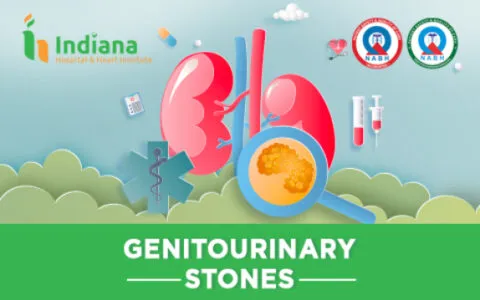GENITOURINARY STONES By Dr. Abijit Shetty
November 17, 2020
The history of urinary stone diseases goes back to ancient Egypt and Mesopotamia. The symptoms of bladder stones have been described even by Hippocrates. The lifetime risk involving kidney stones in industrialised nations is about 16% among men and 6% among women. It can occur at any age. However, the most likely age at which it can strike is after 30. The main causes for stone formation are inadequate hydration, food with too much salt or sugar, and infections; family history might be the cause in some people. Co-morbid illnesses (diabetes and hypertension), gastrointestinal surgeries and disease, prolonged immobilisation and medication may also lead to stone formation. Anatomical abnormalities in genitor urinary system and obesity could also increase the risk of kidney stones.

The 4 major types of kidney stones are:
- Calcium oxalate: 75%: This is the most common type of kidney stone which is created when calcium combines with oxalate in the urine.
- Uric acid: 5%: Here high purine intake due to consumption of organ meat and sea food leads to a higher production of monosodium urate, which subsequently results in stone formation in the kidneys.
- Struvite: 15-20%: This is caused by infections in the upper urinary tract.
- Cystine: <1%: Here stones are rare and tend to run in families.
Common symptoms include severe pain in the lower back, blood in the urine; nausea, vomiting, fever and chills, or cloudy urine. The stone, once formed, may migrate down the urinary tract. Tiny stones, usually less than 5 mm, may move out of the body through urine without causing too much pain. However, some stones don’t move, causing back pressure changes in the kidney or the ureter, leading sometimes to retention of urine in the bladder causing pain.
Kidney stone management
Diagnosis starts with the perusal of medical history, physical examination and imaging tests. The exact size and location of the stones can be determined by X-ray, ultrasound or CT scan. CT scan is usually preferred for accurate diagnosis. The function of the kidney will be evaluated by blood tests and urine examination. The overall function of the kidney and the size and location of the stone will determine the course of treatment. Small uncomplicated stones are usually treated by medically expulsive treatment or ESWL. Complicated stones require surgical intervention in the form of endoscopic and key-hole procedures. In case of recurrent stone formers, the stone will be analyzed. Urine is collected over 24 hours to test for calcium and uric acid.
Painful small stones can be treated with painkillers and alpha-blockers. The patient may be advised to continue drinking specified amounts of fluids to prevent the formation of new stones. Obstructive stones which are not expelled through medical therapy are usually removed through intervention.
The main types of intervention for removing kidney stones are:
- Extra corporeal shockwave lithotripsy (ESWL).
- Cystolithotripsy.
- Rigid and flexible ureteroscopy. (RIRS & URS).
- Percutaneous nephrolithotomy (PCNL).
Reducing the risk of kidney stones
Drink around 2.5 to 3 litres of fluids to maintain the circadian rhythm, and neutral ph beverages, so that your urine is very light yellow in colour, and you remain well hydrated. Your fluid intake should mostly be water. Most people should drink more than 12 glasses of water a day.
For a balanced mixed diet, your food should be rich in vegetables and fibre; there should be normal calcium content and limited salt and animal protein intake. Your lifestyle should be modified to include adequate physical activities and stress-limiting measures; maintain BMI between 18 to 25.
Long-term consequences of kidney stones
Kidney stones increase the risk of developing chronic kidney disease. There is a 50% risk of developing stones within 5 to 7 years.
Dr. Abijit Shetty is the Consultant Urologist at Indiana Hospital, Mangalore
